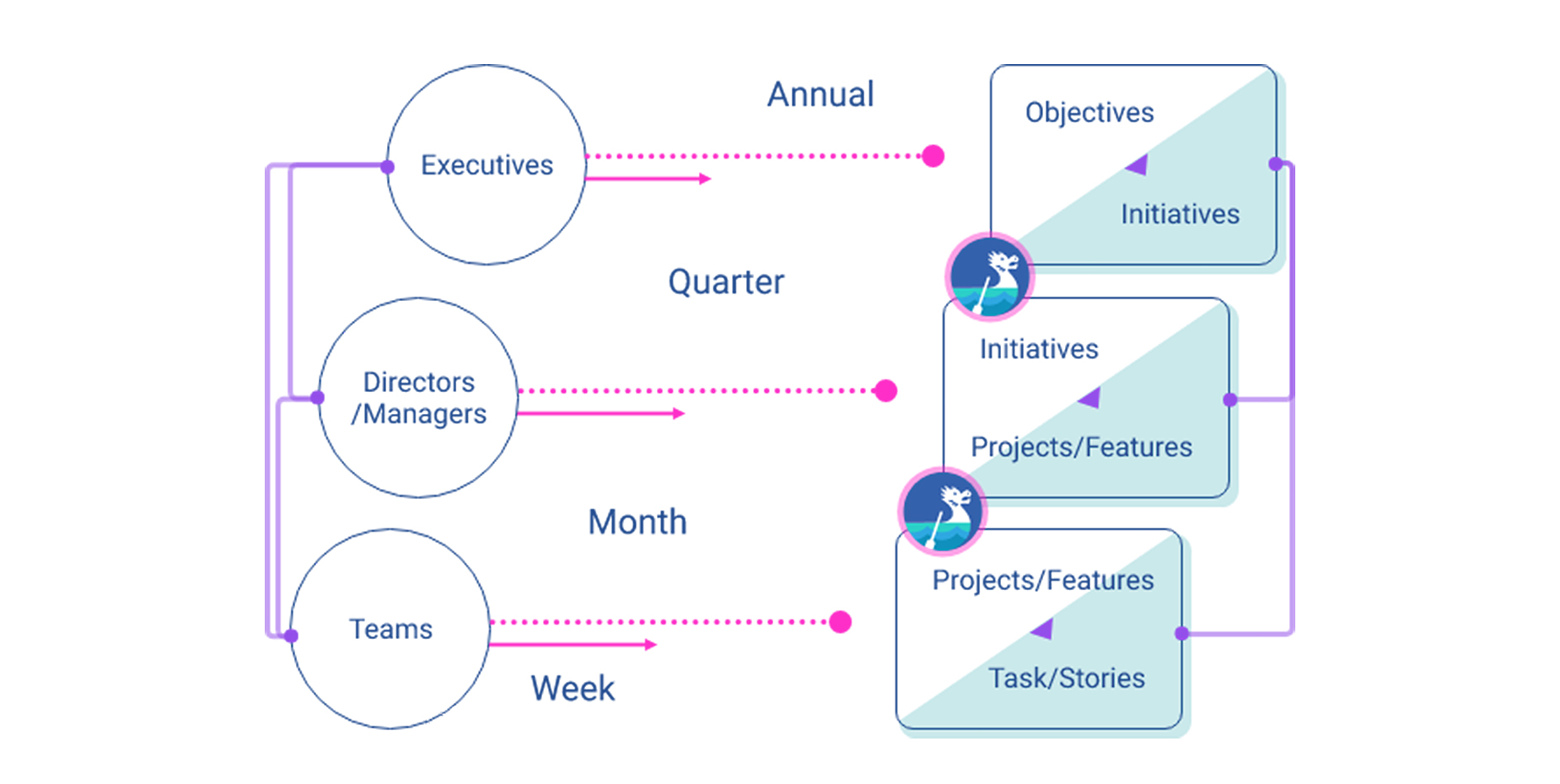When setting product goals, several rules of thumb may be familiar. For example, goals should be aspirational enough to motivate your team, with specific, measurable, and challenging time-bound targets. These rules matter because when used correctly, a product-led company can use goal-setting frameworks, like Objectives and Key Results (OKRs), to accelerate outcomes by enabling top-down alignment, bottom-up innovation, and cross-functional collaboration.
Yet, even the most well-intentioned organizations make mistakes. So, below, we provide an overview of product goals and initiatives, with examples and tips that go beyond the obvious. But first, let us make sure we agree on the definitions.
What Is a Product Goal?
Product goals are broad, agreed-upon targets for your company’s products that are vital to achieving the organization’s short and long-term objectives. They articulate what you want to accomplish within a particular time frame and why.
Goal setting is a collaborative effort that results in an agreement between your company’s executives and the various functions within your organization. Although the CEO is typically responsible for setting the company vision, they rely on their executive team to propose goals and strategies for making that vision a reality, given each functional leader’s area of expertise. To show you what we mean, let’s look at a few examples:
Product Goal Examples
Imagine a product-led SaaS organization with a solution that streamlines communications between schools and parents. This company might set product goals such as the following:
- Triple market share in the Pacific Northwest within one year to double revenues.
- Increase teacher and parent adoption from 70% to 90% within two years.
- Improve our ability to scale by driving efficiencies that allow us to grow our gross margin by 10% annually for three years.
Naturally, moving past the current state of the product to attain a desired future state will require contributions from every business area, not just your product team. But below are the initiatives your product team members might prioritize to support these goals.
What are Product Initiatives?
In product management, we typically use the terms “goals” and “objectives” interchangeably, then break goals down into “product initiatives.” Product initiatives are the actions or “strategies” we will employ to achieve our goals. In other words, they specify what the product team will do to support your business objectives.
Product Initiative Examples
To achieve the example product goals we shared above, a company might establish the following product initiatives for its development team:
- Update our UI with customizable visual elements to support expansion into new regions and schools, allowing customers to localize their shared interface.
- Build and launch features (such as form support and calendaring capabilities) to streamline administrative work like permission slips, conference requests, and volunteer management, thus increasing adoption and stickiness.
- Support the Q3 launch of a teacher task force (trained individuals among our user base who can evangelize the solution) by adding capabilities for identifying and supporting the work of these key users.
- Develop and implement processes, procedures, and tools to improve internal efficiencies and reduce costs.
There would likely be more, but this should give you an idea. As you can see, product initiatives are actionable statements about where you will focus your work.
How Are Product Goals Used?
Product goals and initiatives are critical when managing a product team because they help you prioritize your day-to-day work while remaining focused on the company’s business goals. They give your work purpose, which makes motivating your team and getting things done easier. However, it is vital to remember that your product team’s goals and initiatives will overlap with those set by other departments and that you must gain alignment and coordinate efforts before moving forward.
Another thing to keep in mind is that goal-setting terminology can vary, even within the same company. For instance, if your product team uses an agile framework, like Scrum, to plan and manage its work, that will affect how you think and talk about goal setting. The Scrum Guide (which documents this popular framework for software development) sets long-term “product goals” and the “product backlog” apart from “sprint goals” and the ”sprint backlog,” which guide the everyday work of the scrum team. Other groups within your organization may use different terminology, so you must be mindful of this during communications.
Tips for Setting Impactful Goals
Goals can enable top-down alignment, bottom-up innovation, and cross-functional collaboration when appropriately used. But that’s easier said than done, so here are some tips to remember when making decisions.
1. Connect Your OKRs to Product Initiatives
Sometimes, companies implement OKRs by starting from the top and breaking big goals into smaller pieces for each level of the organization, creating a waterfall effect or “cascading OKRs.” The scope gets smaller with each step-down, and the underlying assumption is that you can stack the smaller items together to achieve a higher goal.
While that sounds straightforward, in reality, it adds complexity. Here are some of the main reasons why cascading OKRs are impractical.
- Most companies have teams that work cross-functionally on multiple initiatives (more on that later).
- When teams focus on their own goals, they become siloed and disincentivized to help others achieve their goals.
- A top-down command and control management style stifles bottom-up innovation and promotes micromanagement.
To overcome these challenges, rather than breaking down goals into different hierarchy levels and assigning them to specific people or teams, break down goals based on the initiatives that support the desired outcome.
For instance, for a company-wide OKR, such as “increase adoption from 70% to 90%,” initiatives should be cross-functional, allowing multiple teams to work towards the same goal. The initiative at our EdTech company to “launch a teacher taskforce” is a perfect example. Marketing could focus on new messaging, sales on nurturing key contacts, and product on creating the ability to identify and support such teachers.

2. Consider How Your Initiatives Impact Other Teams
It’s important to remember that everything is balanced in business, and while setting product OKRs, the law of cause and effect applies. Say the marketing team wants to increase conversions and decides to run experiments, such as lowering the price, extending the free trial period, or reducing friction on the demo sign-up page.
While this might improve conversions, it could cause problems for other teams. For example, if you eliminate some fields in the demo request form, the conversion rate will likely improve, but at the same time, this might generate more work for the sales team. Now, they have to spend more of their precious time qualifying leads.
Respect the balance and the importance of other teams’ goals and initiatives. Set product OKRs that will not negatively impact others if you achieve them.
To avoid such conflict, empower your managers and product owners with tools that support cross-team visibility and collaboration. That will help them create alignment up, down, and sideways while remaining focused on the product vision.
3. Develop and Track Cross-Functional Goals
Since teams don’t live in a vacuum, it will always be true that multiple teams must come together to achieve different goals, which means roadmap dependencies will inevitably occur. Therefore, it is critical to spot, plan for, and track dependencies with a responsive product portfolio management platform.
For example, many product teams plot their goals and initiatives on a product roadmap to ease communication and manage workflows. If your product development plans include launching exciting new features, it will be necessary for the product roadmaps and marketing roadmaps to be in sync.
So, to ensure cross-functional success, keep in mind these three things about setting product OKRs:
- Prioritize your different goals.
- Allocate resources to these goals accordingly.
- Identify and plan dependencies across teams.

These three steps will ensure that everyone across the organization can agree on the main focus at a given time and optimize resources.
4. Provide Visibility Into Goal Progress
One of the telltale signs that your OKRs are not working is when individual contributors and managers stop looking at them over time. “Set it and forget it” doesn’t work. Instead, use a responsive product portfolio management tool to review your OKRs and any progress made consistently and frequently. That will empower the team with the information they need to respond to inevitable changes in the business or market.
Similarly, it’s a mistake to only look at OKRs during performance reviews, relegating them to an HR activity. Track team progress in real time so you can make any necessary strategy adjustments and reallocate before it’s too late. A results-driven product strategy means multiple teams contribute initiatives to achieve the objective. The allocation of resources should, therefore, ebb and flow based on insights gained about what is working and what is not.
5. Balance Short-Term Wins with Long-Term Focus
Product teams must avoid the potentially fatal mistake of not thinking far enough into the future. Striking the right balance between making progress on short-term and long-term goals (aka big bets) keeps companies competitive despite shifts in the market landscape and customer tastes. Remember what happened to Blockbuster when Netflix arrived on the scene? That is where strategic planning plays a critical role so that nothing important falls through the cracks.
One effective way to prioritize is the rock, pebble, and sand technique, balancing impact and effort in imaginary jars representing capacity. Responsive product portfolio management follows this approach but with an adaptation. It incorporates jars of varying sizes, recognizing that at any given time, product leaders must support many goals, compete for the same resources, and allocate them accordingly.
Product Goals: The Bottom Line
Product goals are agreed-upon targets for your company’s products that support your organization’s high-level objectives. But, using them successfully to motivate and manage your team requires finesse. To enable top-down alignment, bottom-up innovation, and cross-functional collaboration, break goals down into the initiatives needed to realize them and develop systems for allocating the work and streamlining communication across all functions.
A product portfolio management solution, like Dragonboat, can make this simpler. Contact us today to schedule a demo.


